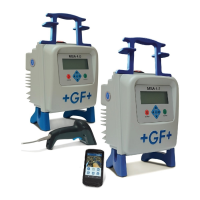
Do you have a question about the GF MSA 4.0 and is the answer not in the manual?
| Power Supply | 24 VDC |
|---|---|
| Operating Temperature | -20°C to +60°C |
| Storage Temperature | -40°C to +85°C |
| Protection Class | IP20 |
| Communication | Ethernet |
| Communication Interface | Ethernet |
| Certifications | CE |
Details the MSA 4.0/4.1 electrofusion control unit for PE/PP pipes, its features, and capabilities.
Details the machine's components, including operation controls, display, and sensors.
Details the standard and wireless barcode scanners used for inputting welding and operator parameters.
Covers power supply extension cables and the use of START/STOP cards for operation.
Illustrates the standard welding workflow with sequence of steps and display messages.
Guides on powering on the machine after connecting to the power source and reading technical characteristics.
Covers entering work site details like operator identity and job number for traceability.
Describes the process of connecting welding terminals to the fitting and automatic detection.
Outlines data entry via barcode reading or manual insertion for fusion parameters.
Describes the alert for high internal temperature that might affect fusion completion.
Explains the optional activation and input of a secondary welding number.
Covers prompts for pipe preparation and aligner installation verification.
Defines traceability data collection for pipes and fittings, required or optional.
Details the input of pipe lengths and trench depth for fusion process tracking.
Explains the GPS receiver for recording geographical coordinates of the jointing place.
Details the welding phase and cooling time, including display information and alerts.
Allows setting the display language and the machine's date and time for accurate logging.
Enables or disables manual input of fusion parameters, bypassing barcode reading.
Enables/disables the prompt for pipe preparation before welding.
Defines how traceability data is handled (required, optional, disabled) during fusion.
Enables operator identity and job number insertion as required or optional.
Allows setting how to manage protocols when memory is full (Reminder, Overwrite, Block).
Enables/disables entry and saving of a secondary welding number related to the job number.
Enables/disables the input and saving of pipe lengths for welding.
Allows exporting machine configuration to a USB stick in XML format.
Allows configuring machine settings based on special customer requests via MSA Configurator.
Enables/disables screens for adding manual or scanned information to fusion records.
Enables/disables the screen asking to confirm correct aligner installation before proceeding.
Shows how to view stored welding protocols on the display, with the most recent appearing first.
Details exporting stored welding protocols to a USB memory stick in PDF or CSV format.
Explains how to permanently delete all stored welding protocols from internal memory.
Lists error messages displayed by the unit, their numbers, and possible causes/comments.
Explains how the EF unit can be configured at different levels by authorized personnel.
Summarizes symbols used to identify different fitting types for manual data entry.
Lists key technical specifications including voltage, temperature, fittings range, and dimensions.
Lists the various ISO, UNI, and EN standards the unit complies with.
Details how to clean the unit, membrane keyboard, and other parts using appropriate materials.
Emphasizes regular control of fusion cables and replacement of damaged ones.
States the requirement for regular functional check-ups by an authorized service agent.
Instructs to contact local representatives for repairs and lists information needed for spare parts.
Specifies conditions for safe operation: qualified personnel, no unauthorized use, and proper environment.
Emphasizes checking the unit for damage and proper function before each operation.
Advises keeping cables away from sharp edges and replacing damaged cables.
Instructs to have damaged units or parts repaired or replaced by an authorized service agent.
States that only authorized service agents can open the unit, warning of electrical hazards.
Encourages contribution to workplace safety, reporting deviations, and maintaining safety awareness.
Mandates separate collection of electronic waste according to WEEE directive.